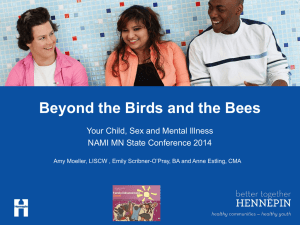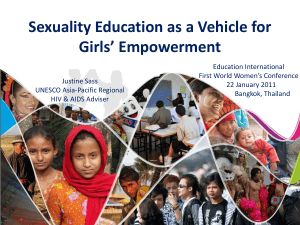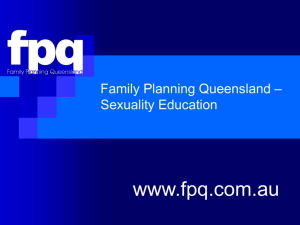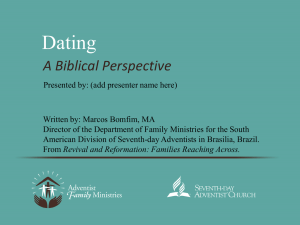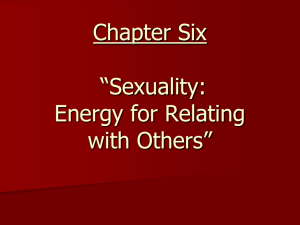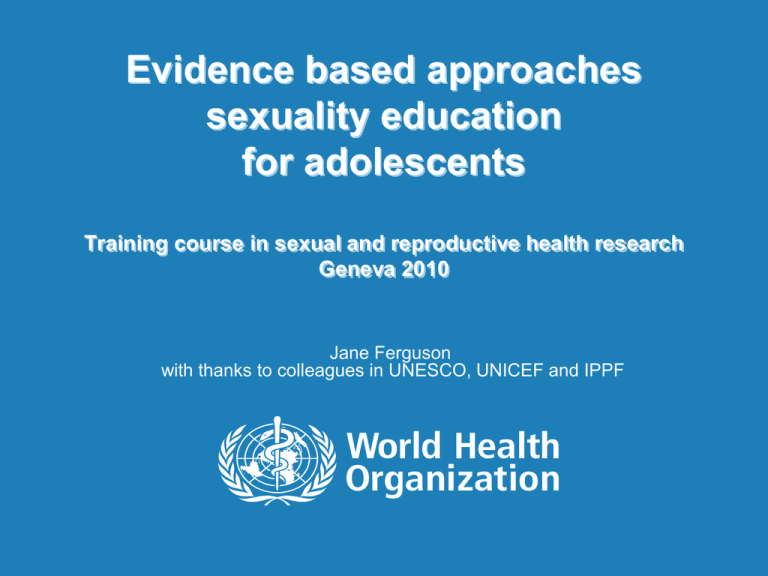
Evidence based approaches
sexuality education
for adolescents
Training course in sexual and reproductive health research
Geneva 2010
Jane Ferguson
with thanks to colleagues in UNESCO, UNICEF and IPPF
Session objectives
To understand what sexuality education comprises and why is it
important for adolescents
To have an overview of some of the consequences among
adolescents of lack of knowledge, skills and unhealthy attitudes
To understand some of the sensitivities related to sexuality
education
To have an overview of the effectiveness, the content and types
and quality characteristics of sexuality education
To be aware of some key international resources available
2
What is sexuality education and why is it
important for adolescents?
Puberty, its accompanying developmental changes, including capacity
for sexual and reproductive function are hallmarks of adolescence
Few young people receive adequate preparation for their sexual lives
Many young people approach adulthood faced with conflicting and
confusing messages about sexuality and gender
Sexuality Education is defined as an age-appropriate, culturally
relevant approach to teaching about sex and relationships by
providing scientifically accurate, realistic, non-judgmental information.
Sexuality education provides opportunities to explore one’s own
values and attitudes and to build decision-making, communication and
risk reduction skills about many aspects of sexuality (UNESCO, 2009)
3
The consequences of ignorance:
1. early pregnancy
Source: Temin, M et al. Why it's the right time: moving on reproductive health goals by focusing on
adolescent girls, Centre for Global Development, 2010
4
The consequences of ignorance:
2. HIV infection
Source: UNAIDS, 2006, 2008, 2009
5
The consequences of ignorance:
3. violence and dangerous relationships
Source: Temin, M & Levin, R. Start with a girl, Center for Global Development, 2009 from unpublished data from WHO multicountry study on women's health and domestic violence
6
The consequences of ignorance:
4. ill-prepared adults
Research and programme experience
suggests that most adolescent boys
and young men need:
information about sexual and
reproductive health,
opportunities to discuss their doubts
about these matters,
access to condoms, and
exposure to messages and role
models that reinforce more genderequitable ways of interacting with
females.
Source: Gary Barker, Engaging Adolescent Boys and Young Men in Promoting
Sexual and Reproductive Health: Lessons, Research, and Programmatic
Challenges, www.popcouncil.org
7
Improvements in comprehensive correct knowledge among young women and
men aged 15-24 but most countries far from 2010 target
Developing countries with 10 or more percentage point increase in the percentage of young women and men aged
15-24 with comprehensive correct knowledge of HIV Source: UNICEF global databases, 2010 (MICS, DHS and other national surveys, 2003-2008)
Young women aged 15-24
Global 2010 target (95%)
31
Namibia 2000-06/07
33
Trinidad and Tobago 2000-06
54
23
Rwanda 2000-05
36
50
Cambodia 2000-05
37
50
25
19
Haiti 2000-05/06
15
Cameroon 2000-06
16
Jordan 2002-07
28
Haiti 2000-05/06
31
36
14
Benin 2001-06
32
35
21
Nigeria 2003-08
23
17
0
Indonesia 2002/03-2007*
3 13
0
10
40
17
India 2001-05/06
39
34
Uzbekistan 2000-05 3
5
42
39
26
Tanzania 1999-07/08‡
29
Tanzania 1999-07/08‡
41
15
Central African Republic 2000-06
54
41
18
Dominican Republic 1999-2007
7
20
Rwanda 2000-05
42
27
Suriname 2000-06
Armenia 2000-05
62
44
Moldova 2000-08*
Gambia 2000-06
41
Namibia 2000-06/07
44
11
Sao Tome and Principe 2000-06
Global 2010 target (95%)
51
Guyana 2000-06
Viet Nam 2000-06
Young men aged 15-24
65
20
30
40
50
60
70
80
90
100
0
33
15
20
40
8
60
80
100
Sexuality education is a solution
The primary goal of sexuality
education is that children and
young people become equipped
with the knowledge, skills and
values to make responsible
choices about their sexual and
social relationships
Sexuality education programmes
usually have several mutually
reinforcing objectives:
• to increase knowledge and
understanding;
• to explain and clarify feelings,
values and attitudes;
• to develop or strengthen skills; and
• to promote and sustain risk-reducing
behaviour
9
The sensitivity of sexuality education
Sexuality is a central aspect of being human throughout life and encompasses sex,
gender identities and roles, sexual orientation, eroticism, pleasure, intimacy and
reproduction
Ignorance and embarrassment about sexuality are very present in most societies. In
many cultures, there is a particular difficulty in accepting It adolescents as sexual beings
There was a "conspiracy of silence" about sexual matters existed into the early years of
the twentieth century. Initial efforts to promote sex education were focused on the
related dangers of medical and moral decline (Moran, J.P. Sex education Encyclopedia of Children
and Childhood in History and Society)
WHO acknowledged that the need for "sex education was increasing" for adolescents
throughout the world and the resistance to the term 'sex education' (WHO, TRS 583,
Pregnancy and abortion in adolescence, 1975)
The role of parents, teachers, religion leaders in providing education about sexuality was
debated in every country (and still is!)
The advent of the HIV/AIDS pandemic strengthened the position of those supporting
sexuality education but raised questions about its effectiveness (Baldo, M. et al. (1993) “Does
Sex Education Lead to Earlier or Increased Sexual Activity in Youth?” Presented at the Ninth International Conference
on AIDS, Berlin, 6-10 June, WHO)
10
The effectiveness of sexuality education –
an overview
1993 global review of evaluations of comprehensive sex education and HIV/
STI prevention programmes showed that they do not increase rates of sexual
initiation, do not lower the age at which youth initiate sex, and do not increase
the frequency of sex or the number of sex partners among sexually active
youth (Grunseit, A. & Kippax, S. Effects of Sex Education on Young People’s Sexual Behaviour,unpublished review, WHO, 1993)
2006 review of evaluations of sex education and HIV/AIDS education
interventions in developing countries showed that most significantly delayed
sex, decreased the number of sexual partners, increased the use of condoms
or contraceptives, or reduced the incidence of unprotected sex (Kirby D et al in Preventing
HIV/AIDS in young people, WHO 2006)
2008 global review showed that sexuality education programmes do not
increase sexual activity. Some sexuality/HIV education programmes delay
initiation of sexual intercourse, reduce number of sexual partners, increase
use of condoms/contraception, reduce unprotected sex, reduce pregnancy
and STI rates. Some do none of these. (UNESCO, International Technical Guidance on Sexuality Education,
2009)
11
The effectiveness of educational interventions
related to sexuality – additional evidence
Promotion of health and gender equality
Complementary interventions: Program M for young women (mulheres and mujeres); H for
young men (homens and hombres) originally developed & validated in Latin America and
the Caribbean consisting of group workshops and campaigns
Impact evaluation from 2 developing countries showed among young men:
increase in gender equitable attitudes, increase in condom use,
decrease in violence against women
• Among young women: increase in gender equitable attitudes, increase
in self-efficacy, increase in communication with partners, decrease in
drug & alcohol use (c.ricardo@promundo.org.br)
School-based programmes to prevent dating violence
Focus on healthy, non-violent relationship skills through practice with peers
to develop positive strategies for dealing with pressures and conflict
resolution without abuse or violence (WHO Preventing intimate partner and sexual violence
against women, 2010)
12
The content of sexuality education
(Key Concepts in UNESCO, International technical guidance on sexuality education, 2009)
1. Relationships
2. Values, Attitudes and Skills
3. Culture, Society and Human
Rights
4. Human Development
5. Sexual Behaviour
6. Sexual and Reproductive Health
13
Quality characteristics of sexuality education
(from UNESCO, International technical guidance on sexuality education, 2009)
14
Good practice
(from UNESCO, International technical guidance on sexuality education, 2009)
Implement programmes that include at least 12 or more sessions
Include sequential sessions over several years
Select capable and motivated educators to implement the
curriculum
Provide quality training to educators
Provide on-going management, supervision and oversight
15
Examples: 1 People's Republic of China
Schools mandated by State Family Planning Law 2001 to
undertake sexuality education
Delivered within the context of health education in all secondary
schools, but aspects also integrated into other subjects
Some pre-service teacher training on sexuality education has
existed since 1994
No national curricula or official materials
Challenge: making space in a crowded curricula; maintaining family
& community support; teacher training and material development
Source: UNESCO, 2010 L e v e r s o f S u c c e s s: C a s e s t u d i e s o f n a t i o n a l s e x u a l i t y e d u c a t i o n p r o g r a m m e s
16
Example: Federal Repubic of Nigeria
Since the late 1990s, expansion of young people’s access to family life and
HIV education has been the education sector’s main response to preventing
new HIV infection
National taskforce that helped to draw up theGuidelines for Comprehensive
Sexuality Education in Nigeria 1996
1999, the National Council on Education, the country’s highest policy-making
body on education, decided that sexuality education should be integrated into
school curricula as a response to the increasing incidence of HIV and other
STIs among young people.
Opposition by States and the public led to renaming to Family Life Education
Implementation now in 30 of 36 States, supported by FLHE teacher manual
and a student textbook
Challenges: belief that sexuality and HIV education encourages sexual
activity; poor conditions in schools; limited materials and trained teachers
17
Resources on sexuality education
18
Conclusions
Sexuality is a core part of the human existence, albeit a
sensitive topic in most societies
Adolescents require information and skills to assist them
to learn about sexuality, to explore their attitudes and
values, and to practise the decision-making and other
life skills they need to make informed choices about
their sexual lives and protect their health
Good international technical guidance and country
examples exist on which to inspire expanded and
improved efforts on sexuality education
19
Assignment
Immediately after reviewing this module, list and
describe briefly 5-10 barriers to expanding or improving
sexuality education in your country or community
Review the resource materials provided and prepare
short (1-2 paragraphs) suggestions on overcoming
these barriers (adapted to your country/community of
course)
20


